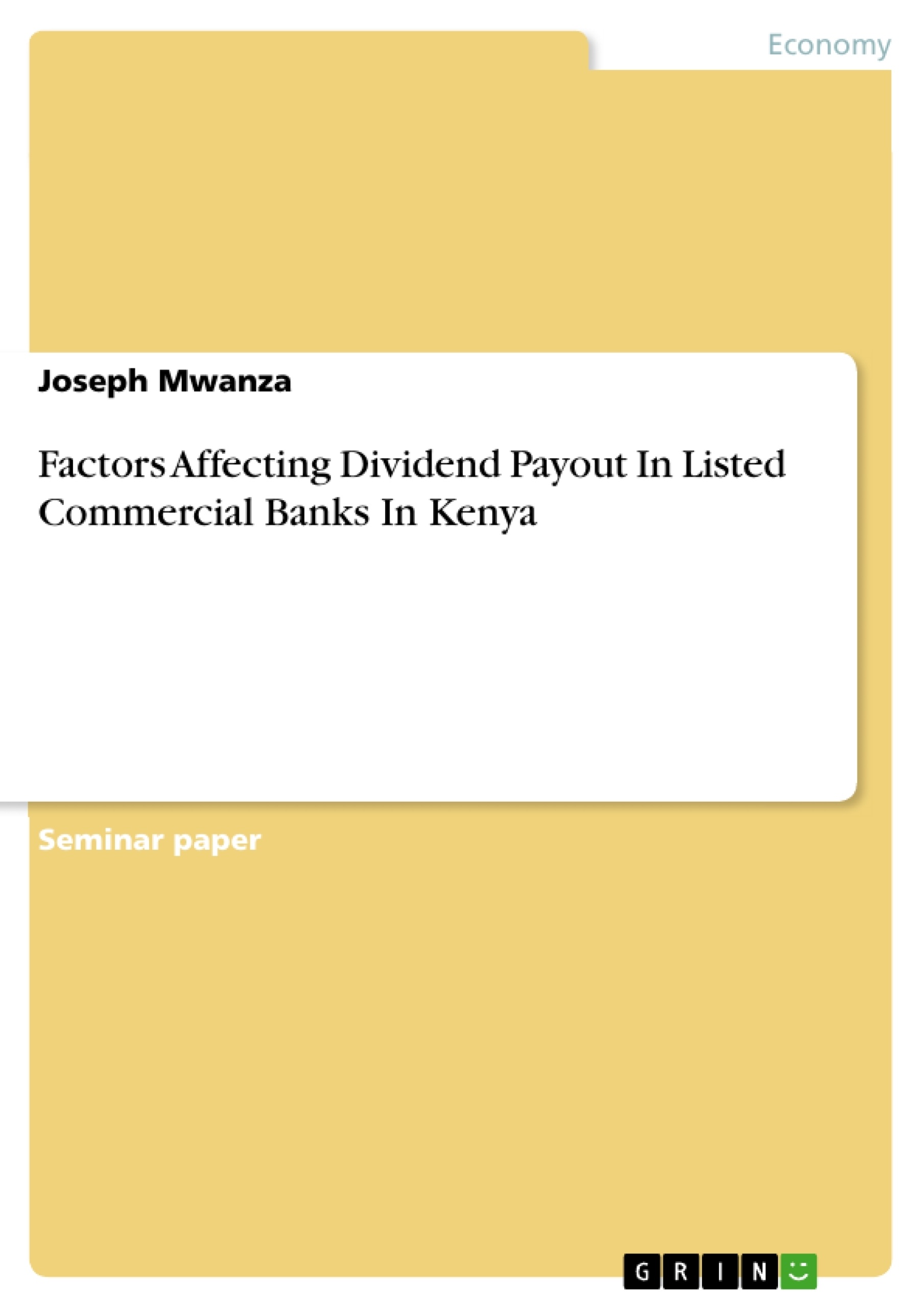This study sought to establish the factors that affect dividend payout of listed commercial banks in Kenya. Specifically, profitability, liquidity, firm size, and past dividend were determined if they affected dividend payout among listed commercial banks in Kenya. The study was based on the Bird in Hand Theory. A correlational research design was used to examine relationship among the variables. The target population for this study consisted of all listed commercial banks in Kenya.
Purposive sampling procedure was used to select listed commercial banks for the study. The study employed secondary data which was obtained from the financial statements of the commercial banks for a period of five years ranging from 2012 to 2016. The study showed that profitability, liquidity, firm size and past DPS accounted for 77.69% of variations in dividend payout for listed commercial banks. All the four factors were found to be significant in affecting dividend payout for the listed commercial banks.
Profitability and past dividend per share were found to be positively correlated with dividend payout while liquidity and firm size were found to be negatively correlated with dividend payout. The researcher recommends more research to be done taking into consideration other factors. These include factors such as the commercial banks management, legal environment, and competition within the banking industry.
Inhaltsverzeichnis (Table of Contents)
- ABSTRACT
- 1.0 Background of the study
- 1.1 Empirical Review
- 1.1.1 Profitability and Dividend Payout
- 1.1.2 Liquidity and Dividend Payout
- 1.1.3 Firm size and Dividend Payout
- 1.1.4 Past dividends and Dividend Payout
- 1.2 Critical Review of Empirical Studies
- 1.2.1 Knowledge gap
- 2.0 Statement of the problem
- 3.0 Objectives of the Study
- 4.0 Methodology
- 4.1 Data collection procedures
- 4.2 Data Analysis
- 5.0 Findings
- 5.1 Descriptive Statistics
- 5.2 Regression Analysis
- 5.3 correlation analysis
- 5.4 Discussion of the Study Findings
- 5.5 Interpretation of the Study Findings
- 6.0 Summary of findings and conclusions This study aimed at establishing the factors affecting dividend payout of listed commercial banks in Kenya.
- 6.1 Summary of the Findings
- 6.2 Conclusion
- 7.0 Suggestions for further Research
- 8.0 Limitations of the Study
- REFERENCES
Zielsetzung und Themenschwerpunkte (Objectives and Key Themes)
This study aims to identify and analyze the factors affecting dividend payout decisions of listed commercial banks in Kenya. The research utilizes the Bird in Hand Theory as its theoretical framework.
- Impact of profitability on dividend payout
- Influence of liquidity on dividend payout
- Relationship between firm size and dividend payout
- The role of past dividends in influencing current payout decisions
- Investigating the significance of these factors on dividend payout in the Kenyan banking context
Zusammenfassung der Kapitel (Chapter Summaries)
The study begins by providing a comprehensive background of the research, exploring the theoretical frameworks and existing literature on dividend policy. It examines different schools of thought regarding dividend payout decisions, focusing on the preferences of investors towards future capital gains versus current cash dividends. The study then delves into the empirical review, analyzing previous research findings on the impact of profitability, liquidity, firm size, and past dividend payout on dividend policy. This review highlights the significance of these factors and identifies potential knowledge gaps in the existing literature.
The study further outlines the objectives and methodology employed, including data collection procedures and analysis techniques used to examine the relationship between the identified factors and dividend payout in Kenyan listed commercial banks. The study presents its findings, utilizing descriptive statistics, regression analysis, and correlation analysis to provide a comprehensive overview of the relationship between the factors and dividend payout. Finally, the study discusses and interprets these findings, drawing valuable insights into the factors influencing dividend payout decisions in the Kenyan banking industry.
Schlüsselwörter (Keywords)
The primary focus of this study lies on dividend payout decisions in the context of listed commercial banks in Kenya. It examines the influence of key financial factors, such as profitability, liquidity, firm size, and past dividends, on dividend payout. The research aims to shed light on the significance of these factors and their impact on dividend policy decisions within the Kenyan banking sector.
- Quote paper
- Joseph Mwanza (Author), 2020, Factors Affecting Dividend Payout In Listed Commercial Banks In Kenya, Munich, GRIN Verlag, https://www.grin.com/document/977795



